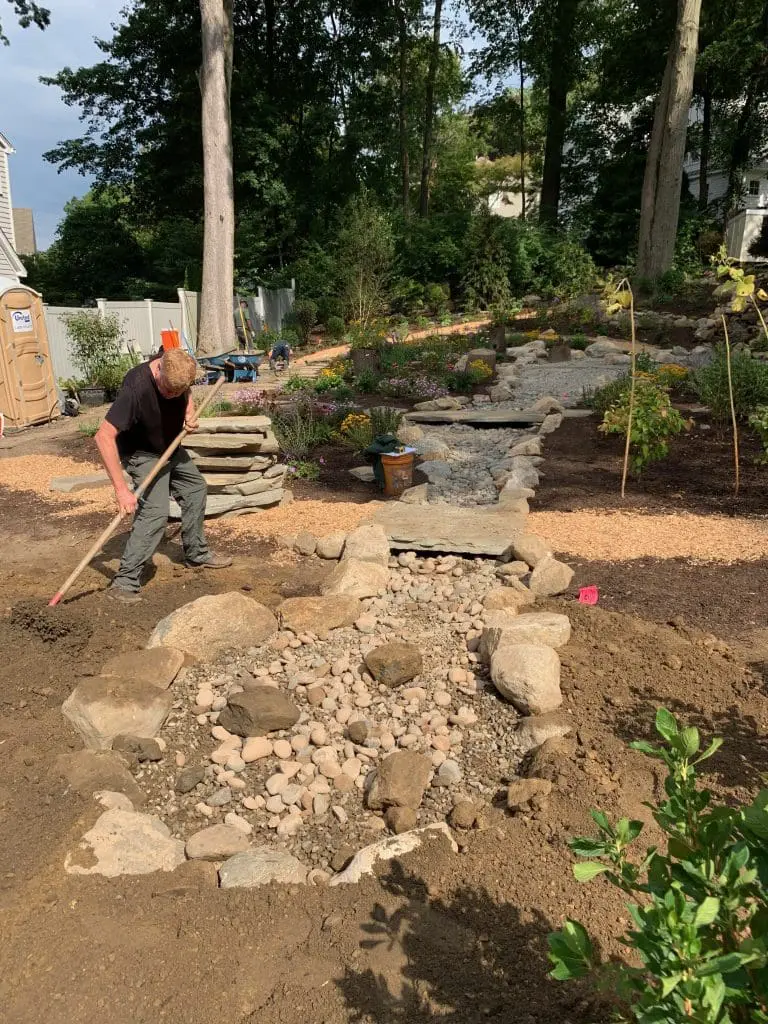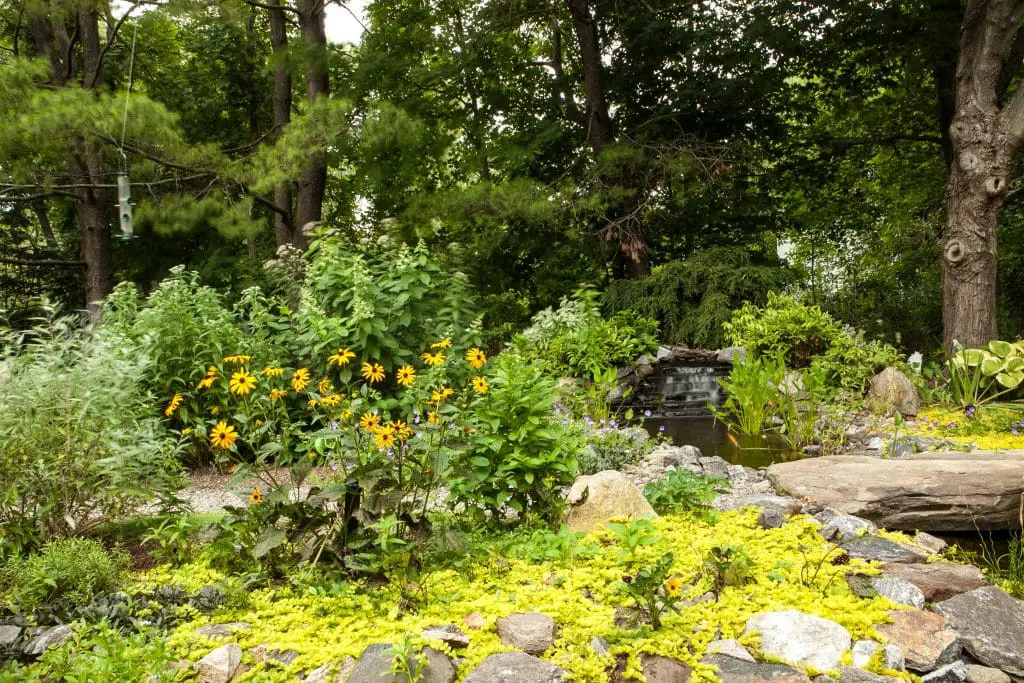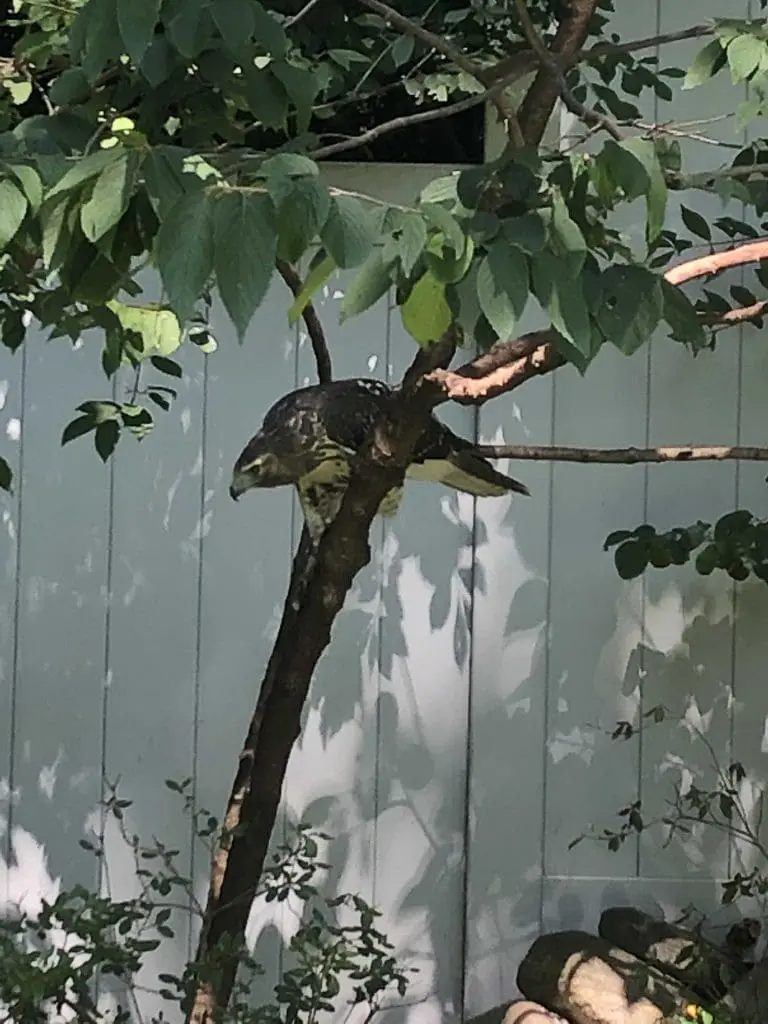Mosquitos are a total nuisance – they can make treasured outdoor spaces unbearable! They are also a public health risk, carrying diseases such as West Nile in the Northeastern US.
This is Step Four of our series on How to Make Our Landscapes Safer & Healthier. Catch up on Steps One and Two and Step Three.
Traditional (Toxic) Mosquito Control
Unfortunately, our hysteria about mosquitos has led to some irrational and downright detrimental “solutions.” Exterminators and ‘Mosquito Squads’ spraying toxic chemicals like Pyrethroids are completely ineffective (mosquitos fly and can avoid these areas) and instead create a negative ripple effect throughout the ecosystem. The USGS found Pyrethroids in stream sediments around urban areas in concentrations toxic to aquatic organisms. Pyrethroids also affect honey bee behavior and motor function, and likely impact other pollinators too.
Lifecycle of a Mosquito
Instead of turning to toxic insecticide, consider an ecological design that manages storm water to eliminate mosquito-breeding habitat. First, it’s helpful to understand the lifecycle of a mosquito:
- Mosquitos lay their eggs in standing water. It takes 4 – 28 days for the eggs to hatch depending on temperature and water conditions.
- In the larval stage, mosquitos stay just under water’s surface, attached with a snorkel-like siphon to breathe, and feed on aquatic organisms for 4 – 14 days.
- Pupal stage — more movement in water but no feeding. Lasts 1.5 – 4 days.
- After emerging from the water as adults, male and female adult mosquitos quickly mate. The male will live about a week, and the female about six weeks (but up to 5 months).
- Only the female takes “blood meals,” after which she lays her clutch of eggs.
So, it’s clear that the easiest way to tackle mosquitos is when they are in one place and not yet moving….aka the larval phase! Mosquito Dunks placed in standing water / breeding locations do just that through a targeted mosquito larvae insecticide that inhibits growth into the adult phase. Learn more about Mosquito Dunks on our previous blog.
Eliminate Standing Water Through Storm Water Management
Mosquito Dunks are largely effective, but even better is to design a landscape that can withstand storm events without ponding for days (creating the dreaded mosquito habitat). Storm water management evaluates the sheet flow, topography, soil conditions, and rainwater infrastructure of a property; from there we develop a custom plan for storm water management that enables landscape drainage.
Storm water plans often embody several tools and design features. For example, a bio-swale helps conduct storm water through a slight channel, usually filled with gravel to help slow down the water and filter out pollutants as it percolates.



In some cases, due to the amount of impervious space on the property and surrounding it, it may be necessary to install a Cultek storm chamber. Storm water collects in the gravel-filled chamber and gradually percolates out. Learn more on our previous blog, Designing a Bird Sanctuary Part One: Site Development & Stormwater.
Passive Irrigation is another great tool to redirect storm water and recycle it as irrigation in your planting beds. Check out this blog for more information about our Passive Irrigation & Rainwater Harvesting Project in Mamaroneck, NY.

Rain Gardens are another incredibly valuable ecological tool for storm water management. They are typically depressed gardens filled with a well-draining soil medium and planted with native plants that can survive both extreme storm events and periods of drought. Rain gardens should be placed above the area of your landscape that is ponding / flooding, so that it can capture and absorb the sheet flow before it reaches the low point and becomes trapped (forming mosquito habitat!).

Typically planted with a mix of native shrubs, trees and perennials, rain gardens also have immense ecological value in the food and habitat they provide for local pollinators and wildlife.
Attract Dragonflies, Natural Predators with a Water Feature
Despite your best proactive efforts to eliminate mosquito-breeding habitat, it is possible for adult mosquitos to fly over to your yard. Therefore, you should have your third line of defense armed and ready: natural predators!

What eats mosquitos?
- Dragonflies
- Damselflies
- Birds
- Bats
- Goldfish
- Frogs & Tadpoles
- Turtles

Believe it or not, you can design a habitat for all of these natural mosquito predators. You may have noticed many of them are aquatic animals. We have designed and constructed numerous fish, frog and turtle ponds / streams, that also happen to be hosts for dragonflies. Landscape around your water feature with native flowering and berry-producing shrubs, and you will attract your native mosquito-feeding birds in no time!

Contact us to discuss your landscape design or storm water management project!